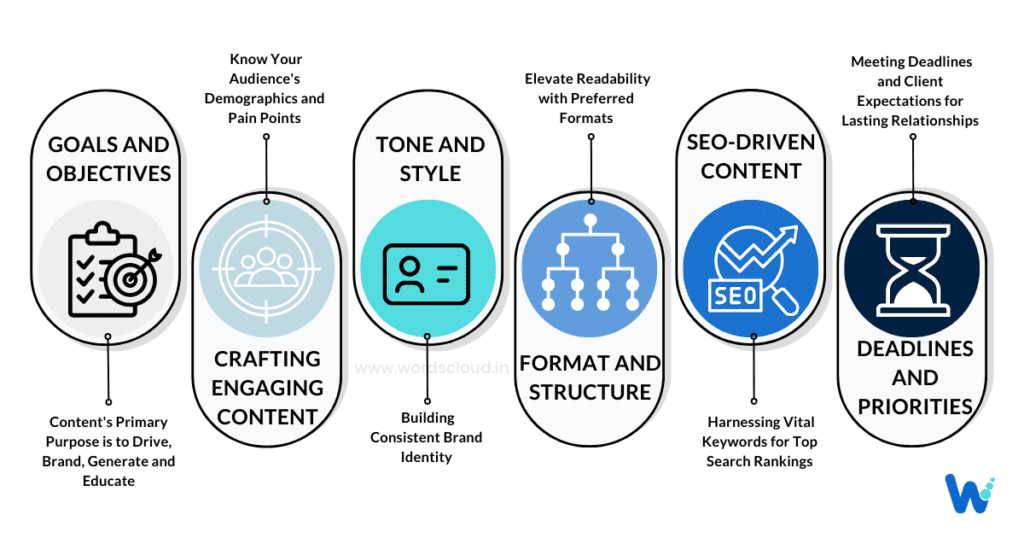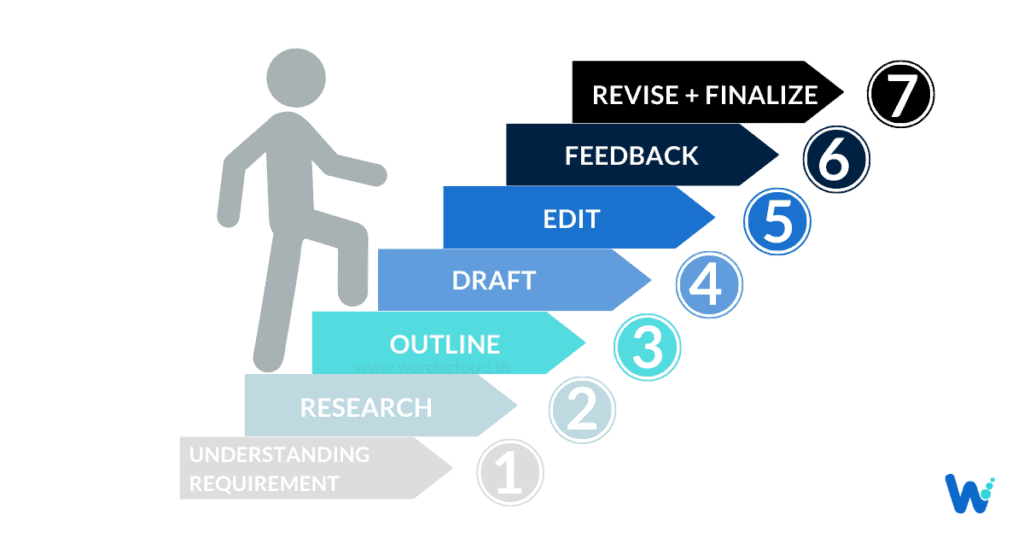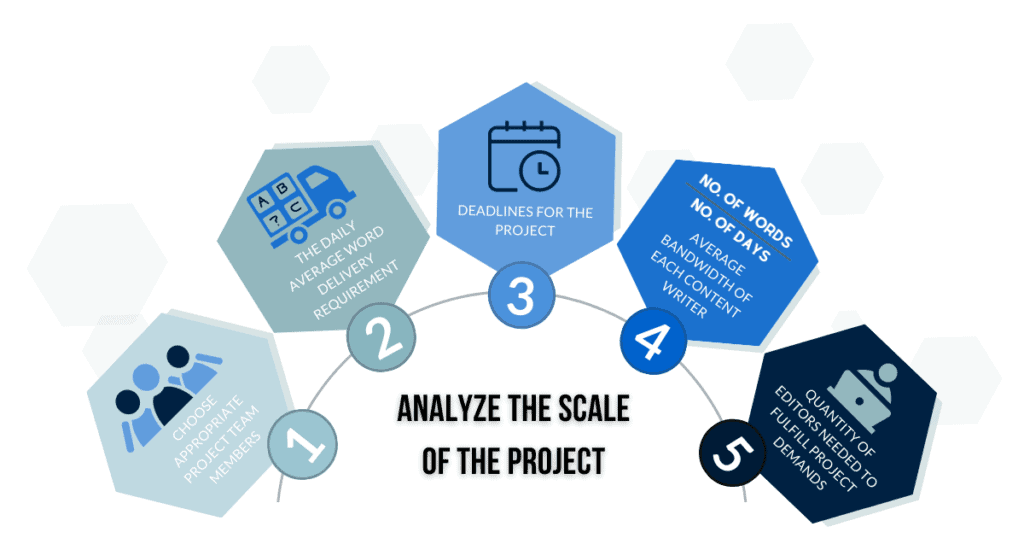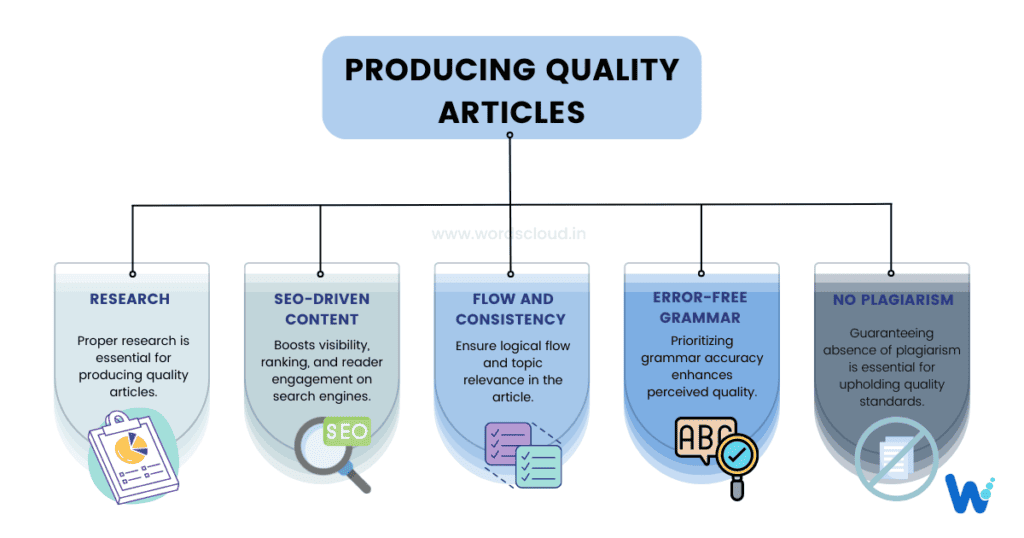Content writing is a crucial task for any business – after all, it’s how brands communicate with their customers. But when the orders start rolling in, and the word count starts piling up, things can get overwhelming quickly.
Marketing strategists know how important quality content is for any company’s advertising campaigns. There might be occasions when companies may require bulk content. From generating emails to creating blogs and product descriptions, agency owners might get huge bulk orders where they might need to deliver hundreds of content pages daily.
Are you dealing with too much content? Are you struggling to meet your deadlines or keep up with the demand from customers? Would you like a faster and more efficient way to manage your bulk content writing orders? Don’t worry – you can find a way to manage large projects without becoming overwhelmed or sacrificing the quality of your content.
In this article, we’ll show you how to manage bulk content writing orders with speed and scale, plus the best tips and tricks for staying organized!
Understanding Bulk Content Writing Orders
Bulk content writing orders refer to a substantial number of articles, blog posts, or other written materials requested by a client, often within a short time frame.
These orders are typically placed by businesses or agencies requiring large volumes of content for their marketing efforts, SEO strategies, or website development.
Handling bulk orders requires a streamlined process, efficient communication, and clear guidelines to ensure the delivery of high-quality, consistent, and timely content.
When clients invest in a good volume of high-quality content, their businesses can experience significant growth. One of the primary advantages is the ability to cover a wide range of potential keywords. This increased keyword coverage helps businesses enhance their online visibility and attract more organic traffic, capturing a larger audience and tapping into various niches within the market.
In addition, having a diverse selection of content allows businesses to cater to different customer interests and preferences, fostering stronger engagement and retention. As a result, they can create a loyal customer base and boost conversions.
Moreover, a large content repository enables businesses to maintain an active online presence, demonstrating their expertise and authority within their industry. This credibility not only attracts new clients but also strengthens relationships with existing ones.
As per a survey, businesses generated 5X better conversion rates by implementing content marketing as their core advertising strategy. Moreover, 70% of businesses spent nearly 10-60% of their marketing budget on content marketing in 2022.
Consider this as the best time to invest in content marketing .
Understanding Client’s Requirement

Effectively managing bulk content writing orders starts with understanding your client’s requirements. This vital step ensures that you create content that not only meets but exceeds their expectations. Here are some crucial aspects to consider when deciphering your client’s needs:
1️⃣ Goals and Objectives:
Determine the primary purpose of the content, such as driving traffic, increasing brand awareness, generating leads, or educating readers. This information will guide your approach and help you align your content with the client’s goals.
2️⃣ Target Audience:
Identify the intended audience for the content, including their demographics, interests, and pain points. This knowledge enables you to create content that resonates with the readers and addresses their specific needs.
3️⃣ Tone and Style:
Familiarize yourself with the client’s preferred tone and writing style. Some clients may prefer a casual, conversational tone, while others may seek a more formal and authoritative voice. Consistency in tone and style is crucial for maintaining brand identity.
4️⃣ Format and Structure:
Understand the preferred format and structure for the content, such as the use of headings, subheadings, bullet points, or numbered lists. Well-structured content improves readability and enhances user experience.
5️⃣ Keywords and SEO:
Gather information on the essential keywords and phrases to be incorporated into the content. This helps with search engine optimization (SEO) and ensures that the content ranks higher in search results, driving organic traffic.
6️⃣ Deadlines and Priorities:
Clarify the deadlines for each piece of content and establish priorities, especially when handling multiple projects. This allows you to efficiently manage your workload and deliver the content on time.
By thoroughly understanding your client’s requirements, you can tailor your content to meet their specific needs, resulting in higher satisfaction rates and fostering long-lasting professional relationships. ✅
Preparing a Comprehensive Project Guideline: A Blueprint for Success 📝
Creating a comprehensive project guideline is essential for managing bulk content writing orders effectively. It serves as a blueprint that streamlines the content creation process, ensures consistency, and helps maintain quality standards.
We at our company always make sure to note these key components to include in our project guidelines:
1️⃣ Creating Overview:
Provide a brief description of the project, its objectives, and the client’s expectations. This sets the foundation for the entire content creation process and ensures that everyone involved is on the same page.
2️⃣ Target Audience:
Define the target audience, including demographics, interests, and pain points. This information helps content creators tailor their writing to engage and resonate with the intended readers.
3️⃣ Tone and Style:
Establish guidelines for the desired tone and writing style, which should align with the client’s brand identity. Include examples or references to ensure consistency across all content pieces.
4️⃣ Content Format and Structure:
Outline the preferred format and structure, such as headings, subheadings, bullet points, or numbered lists. Providing clear instructions on formatting ensures better readability and user experience.
5️⃣ Keyword and SEO Guidelines:
Include a list of target keywords and phrases, along with their desired frequency and placement. This ensures that content creators optimize the text for search engines, increasing its visibility and organic reach.
6️⃣ Deadlines and Priorities:
Specify the deadlines for each content piece and prioritize tasks based on their importance or urgency. This helps content creators manage their workload efficiently and ensures timely delivery.
7️⃣ Revision and Feedback Process:
Define a clear process for reviewing and providing feedback on the content. This ensures that any necessary revisions are made promptly, maintaining the overall quality of the content.
8️⃣ Resources and References:
Provide any relevant resources, such as research materials, data, or client-specific information that will aid content creators in crafting accurate and compelling content.
By taking the time to prepare a comprehensive project guideline, you can ensure that your team has all the information they need to produce high-quality, targeted content that meets quality standards & client expectations.
Creating A Pilot Article

At Wordscloud, We start a new project with a pilot article. A Pilot article serves as a benchmark for quality, style, and format in bulk content writing projects. It’s a crucial step in ensuring consistency and meeting client expectations across all content pieces.
Here’s how to create a pilot article that sets the standard for excellence:
Step 1️⃣ Review Project Guidelines:
Begin by revisiting the comprehensive project guidelines, ensuring you have a clear understanding of the client’s requirements, target audience, tone, style, and formatting preferences.
Step 2️⃣ Do Proper Research:
Gather relevant information, data, and resources that support the topic of the pilot article. This ensures that the content is accurate, informative, and engaging for the target audience.
Step 3️⃣ Create an Outline:
Develop a clear and logical structure for the pilot article by creating an outline that includes headings, subheadings, and key points. This helps organize the content, making it easier to write and more reader-friendly.
Step 4️⃣ Write the Draft:
Craft the pilot article, adhering to the project guidelines and maintaining the desired tone, style, and format. Incorporate the target keywords and SEO best practices to optimize the content for search engines.
Step 5️⃣ Edit and Proofread:
Carefully review the pilot article, checking for grammar, punctuation, spelling, and readability. Ensure that the content meets the quality standards set by the client and is free from errors. Click here to increase readability score of your content.
Step 6️⃣ Ask for Feedback:
Share the pilot article with your client for review and feedback. Encourage open and honest input to identify areas for improvement and ensure the final product meets or exceeds expectations.
Step 7️⃣ Revise and Finalize:
Incorporate the feedback received and make any necessary revisions to the pilot article. This helps set the standard for quality, style, and format for the remaining content pieces in the project.
By creating a pilot article, you establish a clear benchmark for excellence in your bulk content writing project. This ensures consistency across all content pieces, resulting in a cohesive and high-quality final product that aligns with your client’s expectations. 💯
Analyze The Scale Of the Project
Here are a few essential things that are essential to analyze before starting a new bulk content writing project.

Selecting the Right Team Members for the Project
One of the first things you need to do before starting the work on a new project is to analyze the scale of the project in order to determine how many writers, editors & other operation members will be required. At Wordscloud, we consider several factors to analyze the scale of a project, ensuring optimal efficiency and client satisfaction.
Here are the key aspects we take into account:
📚 Volume of Content:
Determine the total number of content pieces required, including blog posts, articles, social media updates, and more. This helps us allocate appropriate resources and create a proper timelines for completing the project on time.
🧠 Complexity of Topics:
Evaluate the level of complexity and expertise required for the content topics. This enables us to assign tasks to content creators with the appropriate skill set and knowledge, ensuring high-quality output.
🔍 Research Requirements:
Analysing the amount of research needed to produce accurate and informative content. This factor affects the time and effort required to complete the project and influences resource allocation.
⏰ Client’s Deadlines:
Understand the client’s expectations regarding the delivery timeline for each content piece. This helps us prioritize tasks, manage workload, and ensure timely delivery without compromising quality.
👩💻 Team Availability:
Evaluating the current workload and availability of our content writers, editors, and project managers. This helps us distribute tasks efficiently, maintain a balanced workload, and avoid overburdening team members.
💰 Budget Constraints:
This is very important that to consider the client’s budget and project scope to ensure that the resources allocated align with the financial constraints. This helps us maintain a cost-effective approach while delivering best quality content.
✍️ Revision and Review Process:
Analyze the time and effort required for revisions and the review process. This helps us allocate adequate resources for content editing and proofreading, ensuring that the final output meets or exceeds client expectations .
It’s a good idea to have more writers and editors than you think you need, just in case someone drops out or the work turns out to be more challenging than expected. This way, you’ll have some extra help to make up for it.
Average Number Of Words That Needs To Be Delivered Daily
Calculating the average number of words that need to be delivered daily is an important factor when managing bulk content writing orders.
By determining this metric, you can set achievable goals for your content writers, ensuring that they maintain a steady pace without becoming overwhelmed or compromising quality.
To calculate the average number of words required daily, you’ll need to take into account the project’s total word count, the number of content pieces, and the project deadline. Once you have this information, divide the total word count by the number of days available for content creation. This will give you the average number of words that need to be produced daily to meet the project deadline.
For example, if a project consists of 50 articles with an average word count of 1,000 words each, the total word count would be 50,000 words. If the project deadline is 25 days, then you would need to deliver an average of 2,000 words per day to meet the deadline.
By setting achievable daily word count goals, you can help your content creators maintain a consistent workflow, ensuring timely delivery and maintaining high-quality output throughout the project.
This approach also allows you to monitor progress and make adjustments as needed to stay on track and meet client expectations.
Deadlines For The Project
Bulk content writing orders have specific deadlines that must be adhered to in order to avoid project delays. Depending on the size and scope of the project, different deadlines will be assigned. It is essential to carefully analyze the project in order to determine what deadlines are achievable and realistic.
For smaller projects, a deadline of one week is usually sufficient. For larger projects, a deadline of two weeks is typically necessary. The most critical factor in determining the appropriate deadline is the amount of content that needs to be written. Once the amount of content is determined, the deadline can be set accordingly.
It is important to note that deadlines are not always flexible. If a client requests an urgency in the project, it is crucial to determine if the new deadline is realistic and achievable before agreeing to the change. If the new deadline is not realistic, it is best to stick with the original timeline and try to deliver the project sooner.
Average Bandwidth Of Each Content Writer
The average bandwidth of each content writer can be determined by analyzing the amount of content that each writer produces on a daily basis. By taking the average number of words written per day and dividing it by the number of days worked, you can come up with a good estimate of the average bandwidth for each content writer.
Number Of Editors Required To Meet The Project Requirements
The number of editors required to meet the project requirements can vary depending on the project. For example, a small project may only require one editor, while a larger project may require multiple editors. The number of editors required will also depend on the complexity of the project and the deadline.
Recruiting Experienced Writers, Editors, And Project Managers

If you are looking to take your content writing operation to the next level, it’s time that you start recruiting experienced writers, editors, and project managers. Here are a few tips to help you find the right talent:
1. Post job listings on relevant job boards and websites. Make sure your job postings are clear and concise and that they include all the necessary information potential candidates will need to know. You can also reach out to relevant professional groups and associations to let them know you’re hiring.
2. Use social media to your advantage. Use social media platforms like LinkedIn, Twitter or Facebook to reach out to potential candidates. Make sure you have a strong online presence and that your branding is on point. This will make it more likely that talented individuals will want to work with you.
3. Screen candidates carefully. When you are reviewing resumes and applications, take your time to screen candidates carefully. Make sure they have the necessary skills and experience for the role and that their writing samples are of high quality.
You can also ask them to write a ‘Test article’ on a selected topic so you can determine if they are suited to work with your agency. Once you’ve narrowed down your candidates, invite them for an interview so you can get to know them better.
4. Offers competitive salaries and benefits packages. To attract top talent, it is important that you offer competitive salaries and benefits packages. Candidates will also be interested in learning about your company culture, so be sure to highlight any aspects of your business that make it a great place to work.
Training Your Team
To ensure that your writers are able to handle bulk content writing projects, it is important to provide them with the proper training.
There are a few key things that your writers will need to know in order to be successful when taking on a bulk content writing project. Essentially, the writers will need to be aware of the different types of content that can be ordered.
📘 Familiarize with Project Guidelines:
Ensure that your team thoroughly understands the project guidelines, including the client’s requirements, target audience, tone, style, and formatting preferences. This helps maintain consistency across all content pieces and aligns with the client’s expectations.
💡 Provide Access to Resources:
Equip your team with relevant resources, such as research materials, data, or client-specific information, to create accurate and compelling content. Providing easy access to resources saves time and enables your team to focus on crafting high-quality content.
📚 Conduct Workshops and Webinars:
Offer workshops and webinars on various aspects of content writing, such as SEO, keyword research, and content marketing strategies. This helps your team stay updated on the latest trends and best practices, enhancing their skill set and boosting their productivity.
👩💼 Organize Peer Reviews:
Encourage team members to review each other’s work and provide constructive feedback. Peer reviews can help identify areas for improvement, share expertise, and foster a culture of continuous learning and growth.
🛠️ Provide Writing Tools:
Introduce your team to essential writing tools, such as grammar checkers, plagiarism detectors, and content management systems. These tools can help streamline the writing process, improve productivity, and ensure the quality of the content produced.
Providing your writers with this training will allow them to successfully manage bulk content writing projects and deliver quality results for your organization. Virtual training sessions with the team members with personal feedback and guidance to the writers will ensure productivity.
Applications such as Google Meet, Whereby, and Zoom Meetings, can be used to deliver online training effectively. You can also schedule weekly meetings on the Google Calendar and set up reminders for each member.
Click here to Read About Content-Centric SEO
Effective Communication With The Aid Of Collaborating Tools

In order to manage bulk content writing orders with speed and scale, it is important to have effective communication between the team and the client. There are a number of collaborating tools that can be used for this purpose, such as WhatsApp, Slack, .
Besides, other applications, such as Skype, Whereby, Google Meet, and Zoom, allows you to connect with your team via video calls. Additionally, features like screen sharing allow you to share a closer look at the working of the project sheets and other requirements with your team.
Creating A Project Sheet To Track Work Progress
The first step when working on a blank Google Sheet is to create a header row. In the first column, label it “Project Name.” In the second column, label it “Due Date.” In the third column, label it “Status.”
Next, fill in the name of your project in the first column and the due date in the second column. For the status column, use a simple coding system: “A” for acknowledged, “W” for In Progress, and “D” for Done.
You can add additional columns to track other important information, such as who is responsible for each task or what type of work it is (e.g., writing, research, design, etc.). You can add another column, particularly for project reviewers, and create a drop-down menu consisting of options, such as ‘Ready To Go,’ ‘Under Review,’ ‘Rejected,’ and ‘Canceled.’
If you need to make changes to a task or project (e.g., change the due date), simply update the information in the appropriate cell. You can also add comments by clicking on the cell and then selecting “Insert comment.”
Use Project Management Software To Track Work Status
Project management software is important for keeping track of deadlines and progress when working on writing projects. When assigning tasks to a team, it is crucial to have a system where everyone can see what needs to be done and when it is due. This helps avoid overlap in work and keeps the project organized.
Additionally, project management software can help manage writers’ workloads by automatically distributing projects based on skill sets and availability. This ensures that projects are completed efficiently and effectively. By using project management software, bulk content writing teams can stay on top of their orders and deliver quality work on time.
Using Scripted Sheets To Automate The Management Process
When it comes to managing bulk content writing projects, using scripted sheets can be extremely helpful in automating the process. Scripted sheets essentially provide a list of instructions for the writer to follow, which can help to ensure that all orders are completed correctly and on time.
Additionally, using scripted sheets can help to streamline the communication between the client and the writer, as all of the instructions and expectations are clearly laid out from the start.
Overall, using scripted sheets can be a hugely beneficial tool in managing bulk content writing projects. Automating the process and providing clear instructions can help to ensure that orders are completed efficiently and accurately.
Producing Quality Articles
Here are a few essential tips that must be noted when creating quality articles.

Research
It cannot be denied that the quality of an article is heavily dependent on the research that goes into it. A well-researched article will be packed with relevant information and will be engaging to read. On the other hand, an article that has not been properly researched will be light on content and will likely bore the reader.
This is why it is so important for writers to take the time to do proper research before beginning to write their articles. By doing this, they can be sure that they include all of the necessary information and that their article will be interesting to read.
Additionally, taking the time to do proper research will help to ensure the accuracy of the article. Nothing is worse than reading an article only to find out that it contains inaccurate information.
In short, proper research is essential for producing quality articles. Writers who take the time to do thorough research before writing their articles can be confident that they are including all of the relevant information and creating an engaging piece of content.
SEO-Driven Content
There are many elements to consider when delivering an article intended for the web. Of particular importance is the role of search engine optimization, or “SEO.” Articles written with SEO in mind can help to ensure that your content is properly indexed and ranked by search engines, making it more likely to be seen by potential readers.
While SEO is just one aspect of writing for the web, it can be a critical one. Taking the time to learn about and implement good SEO practices can help your writers produce better articles that reach a larger audience.
Maintaining Flow And Consistency In Articles
When it comes to producing quality articles, maintaining flow and consistency is key. This means ensuring that the article flows logically from one point to the next and that all points are relevant to the topic at hand.
Learn: How to detect Ai written content
Additionally, it is essential to use consistent language throughout the piece, sticking to terms that are widely understood by your audience. Doing so will not only make the articles more enjoyable to read but will also help to ensure that the message is clear and concise.
No Grammatical Mistakes
It is essential to be aware of the impact that grammatical errors can have on the quality of the work your organization produces. While minor mistakes may not seem like a big deal, they can actually negatively affect the way your readers perceive your writing.
In some cases, incorrect grammar can completely change the meaning of what it is trying to say. This can lead to confusion and frustration on the part of your reader, which is obviously something you want to avoid. Even if the error does not change the meaning of your sentence, it can still make the writing appear sloppy and unprofessional.
Of course, everyone makes mistakes from time to time – nobody is perfect. However, it is essential to proofread the work carefully before sending it off to a client or publisher. Taking the time to ensure that the grammar is correct will go a long way in ensuring that the work is perceived as being of high quality.
No Plagiarism
Plagiarism is a topic of great importance when it comes to the quality of articles delivered to clients. This is because plagiarism can lead to a loss of quality in work and can also result in legal penalties for the company or individual who committed the act.
As such, it is vital to take measures to ensure that all work delivered to clients is original and free from plagiarism. This can be done by using software that checks for plagiarism or by manually checking the work against sources before delivery.
Either way, ensuring that no plagiarism exists in the final product is vital to maintaining quality standards.
Reviewing Articles To Ensure Quality

When it comes to bulk content writing, quality is always king. No matter how large or small the project may be, making sure that the final product is of the highest quality should always be the number one priority.
One way to ensure quality is to review each article before it is published. This can be done by reading through the piece and offering feedback on any areas that need improvement. If there are any errors or issues with the article, they can be addressed before it goes live.
This step may seem like extra work, but it can save a lot of headaches in the long run. By taking the time to review articles before they are published, you can rest assured that the client and the readers will see only your best work.
Ensuring Timely Delivery
It is crucial to ensure timely delivery when managing a bulk content writing order project. This can be done by keeping track of the deadlines and ensuring that the content is delivered on time. It is also essential to communicate with the client to ensure that they are happy with the progress of the project.
Regular Feedback Sessions With The Team And Client

It is essential to have regular feedback sessions with both the team and the client when working on a bulk content writing project. This ensures that everyone is on the same page and that the project is progressing as planned.
Feedback sessions also give everyone an opportunity to voice any concerns or issues they may be having. These sessions should be scheduled regularly throughout the duration of the project.
Conclusion
Content writing can be a daunting task, but with the proper strategy and tools, content can be written faster and more effectively. By creating a checklist to track due dates for each project and recruiting freelancers or an agency to help manage your bulk content orders, you can manage your projects with speed and scale.
With careful planning, budgeting, scheduling, and quality control practices in place, you will have no problem producing engaging content on time.
You can also contact us if you are looking for the right option to produce high-quality content for your bulk writing orders.
Click here to Read More about: Editorial Strategy For Content Writers
FAQs
How can you scale content production?
You can quickly scale content production by creating a solid layout of your content production process, designing a style guide, recruiting excellent writers, organizing and optimizing the content, and delivering timely and regularly auditing content.
How can I organize content?
It is essential to produce content in an organized way. You need to prepare an excellent layout, ensure proper execution, and manage the projects properly with the aid of the right tools. Finally, conducting regular feedback sessions and analyzing the client’s assessments will ensure quality assurance.
What are the important steps in designing a content strategy?
The essential steps in designing a perfect content strategy include understanding the client’s demands, planning, executing, optimizing, and maintaining consistency in delivering quality content.
What are the pillars of content strategy?
The key pillars of designing a content strategy include planning, creating content, optimizing content, and auditing your content regularly.









